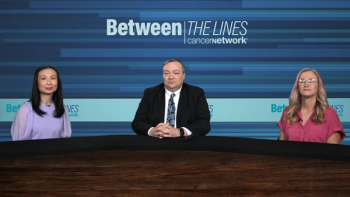
Assessing the Adverse Effect Profile of Ami-Laz in Comparison With Other Combination Therapies in EGFRm NSCLC
Panelists discuss how the adverse effect profile of amivantamab plus lazertinib (ami-laz) compares with other combination therapies, emphasizing its balance between therapeutic efficacy and quality of life, and how this influences decision-making in treatment selection.
Episodes in this series

Video content above is prompted by the following:
Adverse Effect Profile of Ami-Laz Combination Therapy
Adverse Effect Profile of Ami-Laz vs Other Combination Therapies
The adverse effect profile of the amivantamab plus lazertinib (ami-laz) combination therapy has distinct differences compared with other chemotherapy regimens. Although the therapy presents typical toxicities associated with chemotherapy, the adverse effects associated with ami-laz therapy appear to be more manageable and less severe in some cases. However, it’s important to note that patients may still experience certain toxicities, and these adverse effects should be managed proactively.
Integrating the Adverse Effect Profile Into Decision-Making
When deciding whether to use the ami-laz combination therapy, physicians must consider the toxicity and the overall benefit-risk ratio. The therapy has a reported survival benefit, but physicians must weigh the potential adverse effects, especially those that can affect quality of life, against this benefit. For instance, if the therapy has manageable adverse effects, the survival advantage may justify its use. Clear communication with the patient about potential adverse effects and how to manage them is key.
- Survival benefit: A key factor in decision-making is the survival benefit associated with this therapy, which may outweigh the adverse effects.
- Quality of life: Physicians must also consider the patient's quality of life, balancing treatment efficacy with the impact of adverse effects on daily activities and well-being.
The regimen may be especially considered if survival is a primary focus for the patient. Managing adverse effects, such as ocular issues, should be discussed ahead of time so patients know what to expect and how they will be supported throughout the treatment.
Patient Discussions on Balancing Efficacy and Quality of Life
When explaining the balance between therapeutic efficacy and quality of life, physicians should emphasize the importance of survival outcomes while also addressing potential quality-of-life concerns due to treatment-related adverse effects. Most patients are willing to tolerate certain adverse effects if the treatment provides a survival advantage, but it’s essential to ensure that the patient is well-informed on how those adverse effects will be managed.
- Addressing toxicities: Regular follow-ups and clear instructions on managing adverse effects, including potential ocular symptoms, are critical. Physicians can assure patients that measures will be in place to mitigate these adverse effects as much as possible.
- Patient engagement: Engaging patients in the decision-making process by discussing the likelihood of success with this regimen and the importance of adhering to the management plan for adverse effects can help align treatment goals with patient expectations.
Managing the Risk-Benefit Ratio
The overall survival benefit is often compelling enough to justify the use of ami-laz despite the associated adverse effects. As physicians, it’s essential to remain focused on this survival benefit while acknowledging that quality-of-life considerations are significant for the patient. This balance should guide the decision to use ami-laz in clinical practice, particularly in situations where second-line treatments are needed.
In summary, when considering the ami-laz combination therapy, the survival benefit often outweighs the risk of adverse effects, but close attention must be paid to managing these adverse events. Ongoing patient education and support will be critical for achieving optimal outcomes.
Newsletter
Stay up to date on recent advances in the multidisciplinary approach to cancer.


















































































